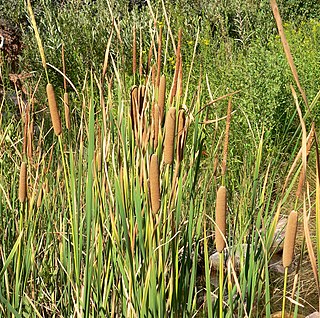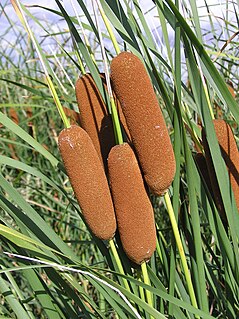
Typha is a genus of about 30 species of monocotyledonous flowering plants in the family Typhaceae. These plants have a variety of common names, in British English as bulrush, or reedmace, in American English as reed, cattail, or punks, in Australia as cumbungi or bulrush, in Canada as bulrush or cattail, and in New Zealand as raupō. Other taxa of plants may be known as bulrush, including some sedges in Scirpus and related genera.

A straw hat is a brimmed hat that is woven out of straw or straw-like materials from different plants or synthetics. The hat is designed to protect the head from the sun and against heatstroke, but straw hats are also used in fashion as a decorative element or a uniform.

A zafu or putuan is a round cushion. Although also a utilitarian accessory, it is best known for its use in zazen Zen meditation.

Typha latifolia is a perennial herbaceous plant in the genus Typha. It is found as a native plant species in North and South America, Europe, Eurasia, and Africa. In Canada, broadleaf cattail occurs in all provinces and also in the Yukon and Northwest Territories, and in the United States, it is native to all states except Hawaii. It is an introduced and invasive species, and is considered a noxious weed, in Australia and Hawaii. It has been reported in Indonesia, Malaysia, New Zealand, Papua New Guinea, and the Philippines.
Punk or punks may refer to:

Typha angustifolia L. is a perennial herbaceous plant of genus Typha. This cattail is an "obligate wetland" species that is commonly found in the northern hemisphere in brackish locations. The plant's leaves are flat, very narrow, and 3'-6' tall when mature; 12-16 leaves arise from each vegetative shoot. At maturity, they have distinctive stalks that are about as tall as the leaves; the stalks are topped with brown, fluffy, sausage-shaped flowering heads. The plants have sturdy, rhizomatous roots that can extend 27" and are typically ¾"-1½" in diameter.

Calamotropha paludella is a species of moth of the family Crambidae. It is found in Europe, Africa, Australia and large parts of Asia.

Typha domingensis, known commonly as southern cattail or cumbungi, is a perennial herbaceous plant of the genus Typha.

The Bulrush Wainscot is a moth of the Noctuidae family. It is found from Ireland and Portugal to southern Fennoscandia, east to western Siberia, the Altai Mountains, Yakutia, Turkey, the Caucasus, Lebanon, Egypt, Arabia, Iraq, Iran, Afghanistan and central Asia.
The Forrestdale and Thomsons Lakes Ramsar Site comprises two separate nature reserves, totaling 754 ha in area, protecting two shallow fresh to brackish, seasonal lakes in a suburban and agricultural landscape in south-western Western Australia. It is used mainly for birdwatching and walking. It lies in the Swan Coastal Plain bioregion. The site is recognised as being of international importance under the Ramsar Convention on Wetlands, under which it was designated Ramsar Site 481 on 7 June 1990.

Conan the Savage is a fantasy novel by American writer Leonard Carpenter featuring Robert E. Howard's sword and sorcery hero Conan the Barbarian. It was first published in trade paperback by Tor Books in November 1992; a regular paperback edition followed from the same publisher in August 1993, and was reprinted in March 1999.

The shy cosmet moth is a moth of the Cosmopterigidae family. It is known from all of Europe, as well as Asia, Australia and New Zealand. It is also present in North America, where it is distributed from Nova Scotia to Virginia, west to Oklahoma and north to Ontario. The habitat consists of fens and marshes.

Typha orientalis, commonly known as bulrush, bullrush, cumbungi in Australia, or raupō in New Zealand, is a perennial herbaceous plant in the genus Typha. It can be found in Australia, New Zealand including the Chatham Islands and the Kermadec Islands), Malaysia, Indonesia, Japan, Korea, Mongolia, Myanmar, Philippines, China and the Russian Far East.

Bulrushes is the vernacular name for several large wetland grass-like plants in the sedge family (Cyperaceae).

Typha laxmannii, common name graceful cattail, is a wetland plant species widespread across Europe and Asia. Typha laxmannii is not as tall as many of the other species in the genus, rarely more than 130 cm high. A noticeable space separates the staminate (male) flowers from the pistillate (female) ones.

Typha capensis is an aquatic plant known from southern and eastern Africa as far north as Uganda. It has also been reported from Brazil.
Typha elephantina is a plant species widespread across northern Africa and southern Asia. It is considered native in Algeria, Egypt, Libya, Mauritania, Senegal, Chad, Eritrea, Ethiopia, Turkmenistan, Tajikistan, Uzbekistan, Palestine, Israel, Saudi Arabia, Yemen, Yunnan, Assam, Bangladesh, India, Bhutan, Nepal, Pakistan and Burma. It grows in freshwater marshes and on the banks of lakes and streams.
Alcea grossheimii is a species of mallow that is endemic to Armenia. It occurs on dry stony slopes, in mountain steppe and in forests, between 750–1,750 m elevation. It is considered by the IUCN to be endangered, as it is only known from five small and fragmented locations.

Arevik National Park, is one of the four protected national parks of the Republic of Armenia. Occupying an area of 344 km2, it is located in the southern Syunik Province of Armenia.
Iris grossheimii is a species in the genus Iris, it is also in the subgenus of Iris and in the Oncocyclus section. It is a rhizomatous perennial, from the Caucasus mountains of Georgia, Armenia and Azerbaijan. It has sickle shaped leaves, which are as long as the short stem, which carries one flower in spring. It is beige, pink or brown covered in dark lines that are, purple-brown or brown. It has a large blackish brown signal patch and brown or black beard. It is rarely cultivated as an ornamental plant in temperate regions, as it needs very dry conditions during the summer.

















